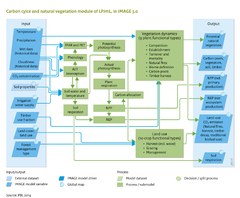Carbon cycle and natural vegetation: Difference between revisions
Jump to navigation
Jump to search
m (Text replace - "Terrestrial CO2 emission - grid" to "Terrestrial CO2 emissions - grid") |
m (Text replace - "Terrestrial CO2 emissions - grid" to "Land-use CO2 emissions - grid") |
||
| Line 6: | Line 6: | ||
|InputVar=Temperature - grid; Precipitation - grid; No of wet days - grid; Cloudiness - grid; CO2 concentration; Timber use fraction; Land cover, land use - grid; Irrigation water supply - grid; Forest management type - grid; | |InputVar=Temperature - grid; Precipitation - grid; No of wet days - grid; Cloudiness - grid; CO2 concentration; Timber use fraction; Land cover, land use - grid; Irrigation water supply - grid; Forest management type - grid; | ||
|Parameter=Soil properties - grid; | |Parameter=Soil properties - grid; | ||
|OutputVar=Potential natural vegetation - grid; NEP (net ecosystem production) - grid; | |OutputVar=Potential natural vegetation - grid; NEP (net ecosystem production) - grid; Land-use CO2 emissions - grid; Carbon pools in vegetation - grid; NPP (net primary production) - grid; Soil respiration - grid; Carbon pools in soil and timber - grid; | ||
|Description=The terrestrial biosphere plays an important role in global and regional carbon (C) cycles and, thus, also in the climate system. Large amounts of carbon, between 2000 and 3000 PgC, are stored in the vegetation and soil components. Land conversions, such as deforestation, have considerably contributed to the increase in atmospheric carbon dioxide over the past centuries ([[Van Minnen et al., 2009]]; [[Houghton, 2010]]) and are projected to continue to do so in the future ([[Müller et al., 2007]]). At teh same time the terrestrial biosphere currently absorbs about 30% of the emitted CO2 ([[Ballantyne et al., 2012]]), and a number of options exists to maintain or even enhance this sink; for example, through protecting existing forests and/or establishing new ones ([[Van Minnen et al., 2008]]). | |Description=The terrestrial biosphere plays an important role in global and regional carbon (C) cycles and, thus, also in the climate system. Large amounts of carbon, between 2000 and 3000 PgC, are stored in the vegetation and soil components. Land conversions, such as deforestation, have considerably contributed to the increase in atmospheric carbon dioxide over the past centuries ([[Van Minnen et al., 2009]]; [[Houghton, 2010]]) and are projected to continue to do so in the future ([[Müller et al., 2007]]). At teh same time the terrestrial biosphere currently absorbs about 30% of the emitted CO2 ([[Ballantyne et al., 2012]]), and a number of options exists to maintain or even enhance this sink; for example, through protecting existing forests and/or establishing new ones ([[Van Minnen et al., 2008]]). | ||
Revision as of 09:05, 29 April 2014
Parts of Carbon cycle and natural vegetation
| Component is implemented in: |
|
| Related IMAGE components |
| Models/Databases |
| Key publications |
| References |
Key policy issues
- What is the role of the terrestrial biosphere in the global carbon cycle, how will it change in time as a result of climate and land-use change?
- To what extent can the terrestrial biosphere contribute to reducing the accumulation of CO2 in the atmosphere and what are viable mechanisms?
- What opportunities exist to reduce land-use related carbon emissions (e.g. REDD) and even enhance the carbon uptake through the establishment of new forests.
- What are the contributions of land-use change, climate change and CO2 fertilization on the future carbon cycle and how can these be considered in climate policies?
Introduction
